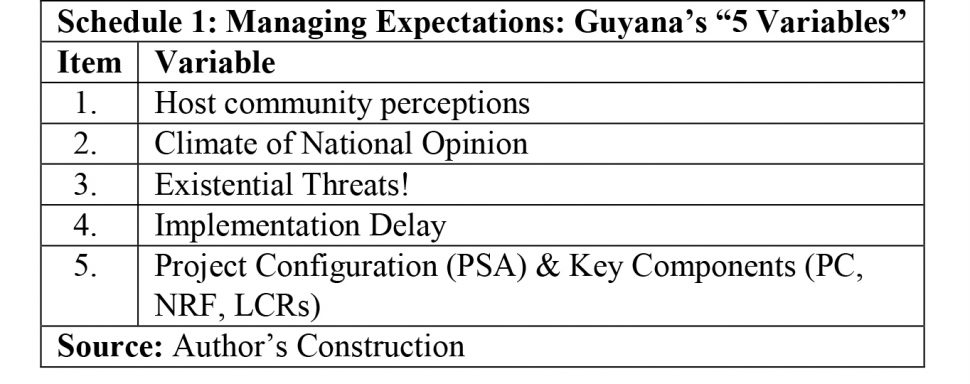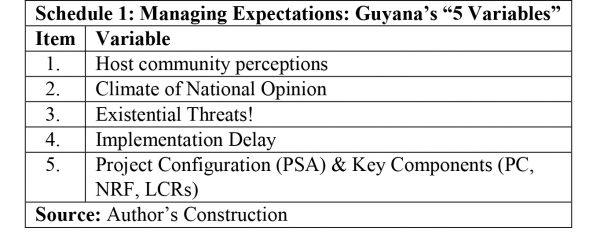Last week’s column dealt with a few of the more theoretical aspects of the role that “public expectations” play in general economic growth theory and the modelling of natural resources policy management. Today’s column focuses on the specifics of managing these expectations as a development challenge facing Guyana, as it seeks to spend its expected Government Take, anticipated to come on-stream circa the mid-2020s.
Experiences elsewhere reveal that managing public expectations can be summarily expressed as a simple function of several societal variables. In the case of Guyana, I shall concentrate on five of these variables as the country seeks to realise the value of its petroleum wealth through production and export. To be sure, these five variables are not exhaustive; however, I believe, they represent the most crucial, given circumstances prevailing in Guyana.
Five Variables
The first variable is derived from the widespread observation that the host community (or local geographic area) where natural resources are discovered is of crucial importance for setting the national tone. Experiences further reveal that the impact on the host community is likely to be greater, the larger is the resource find. The second variable is of equal significance. That is, the climate of national opinion. This indicates prevailing expectations in regard to the successful commercialisation of the resource find. Together, these two variables indicate how substantial the impact of both variables on public awareness and consciousness.
Thirdly, there are public expectations as regards the risk that the petroleum prospect might be terminally aborted! That is, the petroleum wealth is not realised in the nation’s income. The risk is, therefore, existential. (In the next Section, I indicate two such risks in Guyana.)
The fourth variable is a variant of the third. That is, the risk of such considerable implementation delay, as to make the project’s time-horizon for realisation generational.
The fifth and final variable I shall pursue is the national perception of the overall configuration of the natural resource project and its principal components. Guyana’s overall configuration is captured in the 2016 Production Sharing Agreement (PSA) and its key components are represented by: 1) Governance of the project. This is principally concretised in the proposed Petroleum Commission (PC); 2) Revenue management. This is principally concretised in the Natural Resources Fund (NRF); and 3) The development profile. This is principally concretised in the legislation pertaining to local content requirements (LCRs).
Performance: Variable 1
How have these variables performed in Guyana thus far? In regard to the first, I refer readers to a research study on managing public expectations, undertaken by the King Abdullah Petroleum Studies and Research Center (KAPSARC) on Eastern Africa, published in 2016. In summarising its “first-hand research effort after two years,” KAPSARC reported: 1) “there was a state of euphoria” in anticipation of oil wealth and windfall revenues based on reported discoveries; and 2) host communities where the discoveries were made then adopted “mistaken beliefs about their future prosperity.” However, as time elapsed, and the expected riches failed to arrive, there was the “perception that foreigners and domestic elites had captured the benefits.” Following this outcome, host communities were “aggrieved that they did not receive their fair share of the petroleum wealth” (my emphasis).
However, Guyana’s discoveries have been exclusively located offshore, in deep and ultra-deep water. The threat of “host community plunder” is, therefore, virtually unknown, because of the offshore location of the finds. I hasten to acknowledge ,however, there is the possibility of onshore discoveries. For now this entirely serendipitous outcome makes the task of managing public expectations in Guyana significantly “easier,” if the experiences of KAPSARC are taken into account.
Performance: Variable 2
As regards the second variable, (the climate of national opinion), media commentaries in Guyana have painted a dystopian vision of Guyana’s future with its petroleum wealth. Negative stereotyping has left much of the impressionable public deeply fearful of Guyana’s coming oil and gas production and export. Expectations have also been dumbed down by the sheer mediocrity of the wholesalers (so-called experts) and the retailers of their expertise. Prolific bad-mouthing of the Authorities has combined with ill-informed and ill-understood pronouncements, loaded with malicious intent and masqueraded as fair and informed comment/analysis.
I have described the state of opinion bluntly because I wish to advance the view that the unintended consequence of the barrage described above is that there is not a “state of euphoria” about Guyana’s petroleum wealth, as KAPSARC research in Eastern Africa has revealed. Instead, (as I shall develop at some length later,) the dystopian lottery-syndrome vision portrayed of Guyana and its petroleum wealth stands in glaring contradiction to the facts. In particular, the revealed rapid rate at which petroleum finds have been made in recent years and their significant sizes. From an estimated proven reserve of 600 million barrels of oil in 2015, today’s estimate is 6 billion barrels. Furthermore, the actual transition from resource discovery in 2015 to anticipated production and export by 2020 is historically unprecedented!
Performance: Variable 3
It is a matter of considerable curiosity that the dystopian vision of Guyana and its petroleum wealth has been ambivalent about the existential threats facing Guyana (the third variable listed above). Broadly speaking, there are two such threats: one is environmental and the other geo-strategic. The petroleum discoveries have been, to date, all made offshore and in a frontier region of ultra-deep water. The risk of an environmental catastrophe is, therefore, real. And, some have consequently advanced the preposterous position that Guyana should not allow petroleum operations to commence until there is an iron-clad 100 percent guaranteed environmental protection for Guyana and neighbouring states!
There have been few, however, who do not see this as pure folly. And, to this extent, the dystopian vision has had little purchase. There is no strong popular belief in an inevitable, or indeed imminent environmental apocalypse.
Conclusion
Next week, I shall wrap-up this discussion on managing public expectations and conclude comments on the performances of variables 4 and 5.








